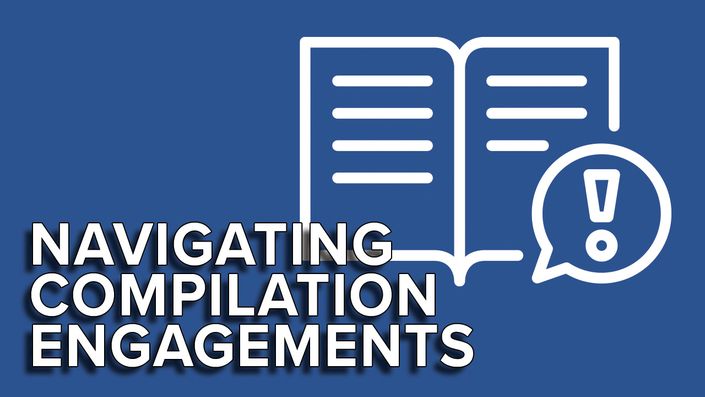
Compilation Engagement Guide
Compilation Standards and Sorting Through the Dog's Breakfast of Client Provided Accounting Information
Watch Promo
NOTE: While this course does provide a series module on the new Compilation Engagement Standard (CSRS 4200) regulations by the CPA Association, it also focuses on handling the data and workflow in a tax practice dealing with small owner-managed businesses.
This course content is also available to subscribers of the Tax Bytes Practice Mentor newsletter which is a monthly subscription service offered here at Canadian Tax Academy. You may wish to subscribe to that service and get access to all the modules included in this course.
Are you considering starting a professional tax practice and looking for a glimpse into what you can expect from clients?
Are you a practitioner or bookkeeper dealing with small businesses that is looking at ways to sort through the maze of information provided by clients to prepare a financial statements? Would you like to be able to cut down on the amount of work that you do and still prepare accurate books and records?
This course will provide you with advice and direction on how to deal with a number of scenarios you will encounter in a typical tax practice focusing on small business clients.
PART ONE – FOUR IN-DEPTH MODULES
New Compilation Engagement Standards – CSRS 4200
For December 2021 fiscal year ends, the CPA Association has released new practice standards that replace the dated Notice to Reader engagement service we have all been accustomed with since the late 1980’s. The first portion of this course deals with the new standards and what will be required of public practitioners who compile financial information for their clients.
Differences Between Compilation, Review & Audit Engagements
New students or those getting into the world of bookkeeping may not know the difference between a compilation and other types of engagements performed by accountants. These tutorials will provide you with the critical details on these engagements and what you can and cannot do for clients without a public license.
Can anyone do a review engagement on a client’s file? Are you able to do an audit of a small business’ books if they tell you the bank needs them? Did you know that all corporations in Canada are required to have a public accountant audit the financial statements of the company? Is there any way around this? If so, how?
These tutorials will answer these questions and what you need to do in these types of situations.
PART TWO – SIX IN-DEPTH & PRACTICAL MODULES
Year-end Process When Client Provides Trial Balance
Many clients will either have a bookkeeper helping them with their books, or they will attempt to use accounting software themselves to do all of their own bookkeeping. How can you tell whether or not the trial balance (or accounting file you receive) is reliable? How can you gauge the experience or knowledge of the person entering the transactions? Do the client’s closing retained earnings from the prior year match what you have in your file? These questions are examined along with real world examples of trial balances provided by clients along with how to analyze them to ascertain what you need to do on the file and prepare your workflow.
File Maintenance
Useful tips and strategies on maintaining and keeping your files so that you can always be on top of everything that is going on with clients with the click of a button. In this module, we look at another trial balance client, but we actually start performing the engagement and preparing the working paper files for a mock engineering firm.
We also examine the integration of working paper files with other work that needs to be done for the client such as T4/T5 and preparation of the T2 tax return. This module will help you build your file system so that you can run your practice more smoothly and know where to find all the information you need on a client.
Client Provide Spreadsheets
Many of our clients are well versed in using spreadsheet programs to track all of their income, expenses and other accounting information. Can we compile financial statements using spreadsheets, and if so, how to we go about doing that in an effective and accurate way? This is the way many I/T and other service professionals provide us with information. With a good system to capture and record their financial information, you can turn these into very profitable clients.
Client Mash-Up
It would be great if all our clients had some knowledge of bookkeeping, but the fact of the matter is that most of them don’t. In fact, there will be many clients you will deal with that have a hard time even keeping themselves organized, let alone provide you the information you require to complete the engagements. In this module, I help you navigate through client who’s books are a “dog’s breakfast.” How do you sort through this mess without spending countless hours on the file that you know you won’t be able to bill the client for?
Imperfect Information
“I haven’t filed my corporate or personal taxes for 5 years .. can you help?” This module will help you try to answer this question and what you can expect when you deal with these types of clients. These specialized engagements are quite tricky and require some extra steps and due care in completing. Some accountants and bookkeepers avoid them like the plague (and rightfully so), but to those practitioners who enjoy challenging work, they can be quite profitable. This module helps you put a process and system in place to help guide you through all the risks and challenges.
Once you have completed this course, you will have a good understanding of both the professional standards you need to comply with, along with a system for dealing with clients and the various methods they use to track their accounting and transactions.
Your Instructor

Ian DINovo is a professional accountant and Director of the Canadian Tax Academy. He has been practicing accounting and offering independent financial and business advice for over 20 years.
He is the creator of a number of courses dealing with business, tax and investment matters that are designed to make difficult topics easy to understand for everyone.
Course Curriculum
-
StartIntroduction to this course - how it is laid out and how it is presented (7:29)
-
StartRefund policy - certificates - questions and other administrative matters (6:25)
-
StartNotes on how to use the content and the evergreen nature of all the tutorials (3:08)
-
StartPowerPoint and PDF notes on material and guidance on notes (2:14)
-
StartA quick note on tutorials, software and the forms you'll see throughout the course (6:21)
-
StartBefore we get started - Some advice on how implement course info (6:11)
-
StartCOURSE NOTES - Download the course PDF files and/or the PowerPoint Presentation
-
StartNew Compilation Standards - Overview of Standards & New Compilation Engagement Report (3:28)
-
StartThe new compilation standard for Notice to Reader Engagements (7:52)
-
StartA brief history including why and how we got here (8:13)
-
StartExceptions to the new compilation engagement standards (7:02)
-
StartIndependence assessment - Review of prohibitions and threats (7:59)
-
StartHow to solve the independence problems under new Standard (5:24)
-
StartAn overview of the new compilation engagement report (5:02)
-
StartDate of the Compilation Engagement Report (3:34)
-
StartResponsibilities after the CER date and decision to amend (5:54)
-
StartThird Parties & Basis of Accounting (1:54)
-
StartStandards to be followed before accepting or continuing an engagement (4:47)
-
StartA discussion on third parties and what practitioners need to know (8:29)
-
StartIs the CRA considered a third party for Compilation purposes? (5:58)
-
StartOverview of the basis of accounting standard (5:38)
-
StartAn overview of the possible accounting basis alternatives (10:01)
-
StartThe engagement letter as documentation and acknowledgement (6:09)
